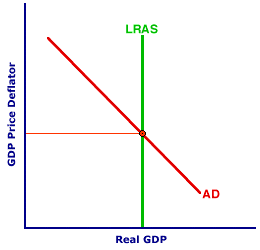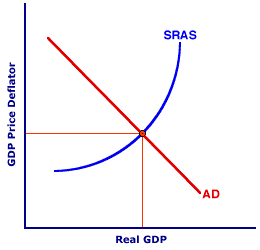
|
|
QUALITY OF LIFE: A common term used to indicate the overall level of well-being or welfare of a person or group of people, taking into account both monetary and non-monetary factors. This notion is theoretically synonymous with utility and the satisfaction of wants and needs. However, from a practical standpoint, attempts have been made to measure the quality of life, primarily as a means of comparison between communities. Quality of life measures are composite indexes based on monetary factors such as income, wages, living costs, and taxes, combined with non-monetary factors such as crime rate, air quality, and education level.
Visit the GLOSS*arama
|
|


|

|
                           LONG-RUN AGGREGATE MARKET: A macroeconomic model relating the price level and real production under the assumption that ALL prices are flexible. This is one of two aggregate market submodels used to analyze business cycles, gross production, unemployment, inflation, stabilization policies, and related macroeconomic phenomena. The other is the short-run aggregate market. The long-run aggregate market isolates the interaction between aggregate demand and long-run aggregate supply. The key assumption of this model is that ALL prices, especially resource prices, are flexible. The primary result of this model is that the economy achieves long-run equilibrium at full-employment real production. The long-run aggregate market is one of two submodels of aggregate market analysis. It builds on the assumption that all prices are flexible in the long run. This price flexibility ensures that all macroeconomic markets--product, financial, and resource--achieve equilibrium with no surplus or shortage imbalances.The distinguishing feature of the long-run aggregate market is a vertical long-run aggregate supply curve. The long-run aggregate supply curve is vertical at the full-employment level of real production. In other words, the long-run aggregate market can achieve equilibrium at a wide range of alternative price levels, but at only ONE level of real production--full-employment real production. Three Markets in OneTo be technically precise, the long-run aggregate market is the long-run aggregate "product" market. Including this extra term highlights the fact that the long-run aggregate market is the aggregation of the economy's product markets, markets that exchange final goods and services, or gross domestic product. However, two other aggregated macroeconomic markets, financial and resource, are also working behind the scenes of the long-run aggregate market model.- Financial Markets: These are markets that exchange legal claims on physical assets. These financial instruments include stocks, bonds, banks accounts, and paper currency. Financial markets provide the liquidity (money and loans) that buyers use to purchase the production exchanged through product markets.
- Resource Markets: These are markets that exchange the services of the four factors of production--labor, capital, land, and entrepreneurship. Resource (or factor) markets provide the inputs that producers need to produce and supply the output exchanged through product markets.
Long-run price flexibility is perhaps most important for the resource markets. In the long run, flexible prices ensure that resource markets are in equilibrium. There are neither surpluses nor shortages in the resource markets, meaning there is neither cyclical unemployment or overemployment of resources. For this reason, equilibrium in the long-run aggregate market exists when all three aggregate markets--product, financial, AND resource--are in equilibrium simultaneously.The Graphical Model| The Long-Run Aggregate Market |  |
The exhibit to the right illustrates the basic components of the long-run aggregate market. Like any aggregate market model, the vertical axis measures the price level (GDP price deflator) and the horizontal axis measures real production (real GDP). The negatively-sloped curve, labeled AD, is a standard aggregate demand curve and the vertical curve, labeled LRAS, is the long-run aggregate supply curve.Long-run equilibrium occurs at the intersection of the AD and LRAS curves. Price flexibility ensures that all three aggregated macroeconomic markets--financial, product, and resource--are in equilibrium at the intersection of the AD and LRAS curves. Because the LRAS curve is vertical at full-employment real production, long-run equilibrium necessarily occurs at full employment, regardless of shifts in the AD curve or changes in the price level. To demonstrate that long-run equilibrium occurs at the same full-employment level of real production should aggregate demand change, click the [AD Increase] and [AD Decrease] buttons. An increase in aggregate demand leads to a higher price level, but the same level of real production. A decrease in aggregate demand leads to a lower price level, but also the same level of real production. Classical RootsThe roots of the long-run aggregate market can be found in classical economics. Many of the propositions of classical economics, especially flexible prices, are incorporated into the long-run aggregate market. Not surprisingly, the classical economic implication of full employment is also implied by the long-run aggregate market. For this reason, the long-run aggregate supply curve is frequently termed the classical aggregate supply curve. The Short-Run Alternative| The Short-Run Aggregate Market |  |
The long-run aggregate market is one of two submodels that make up aggregate market analysis. The other is the short-run aggregate market. The short-run alternative is based on the proposition that some prices, especially resource prices, are inflexible. Inflexible prices gives rise to a positively sloped short-run aggregate supply curve. Equilibrium in the short-aggregate market can be achieved even though the resource markets are out of balance, with either cyclical unemployment or overemployment of resources.The exhibit to the right presents the standard aggregate demand (AD) and short-run aggregate supply curves (SRAS) that make up the short-run aggregate model. Most notable, the intersection of the AD and SRAS curve indicates equilibrium in the product (and financial) markets, but not necessarily equilibrium in the resource markets. The equilibrium level of real production, as such, could be generating full employment of resources, or it could be less than or greater than full employment.

Recommended Citation:LONG-RUN AGGREGATE MARKET, AmosWEB Encyclonomic WEB*pedia, http://www.AmosWEB.com, AmosWEB LLC, 2000-2024. [Accessed: May 14, 2024].
Check Out These Related Terms... | | | | | | |
Or For A Little Background... | | | | | | | | | | | | |
And For Further Study... | | | | | | | | | | | |
Search Again?
Back to the WEB*pedia
|



|

|
PINK FADFLY
[What's This?]
Today, you are likely to spend a great deal of time touring the new suburban shopping complex looking to buy either a how-to book on home decorating or a set of luggage with wheels. Be on the lookout for attractive cable television service repair people.
Your Complete Scope
This isn't me! What am I?
|

|
|
Parker Brothers, the folks who produce the Monopoly board game, prints more Monopoly money each year than real currency printed by the U.S. government.
|

|
|
"I don't know the key to success, but the key to failure is trying to please everybody. " -- Bill Cosby
|

|
AOM
Australian Options Market
|

|
|
Tell us what you think about AmosWEB. Like what you see? Have suggestions for improvements? Let us know. Click the User Feedback link.
User Feedback
|


|


